
Introduction
In December we took at look at
Eizo's EV2450 display, a 23.8" sized 16:9 format IPS model providing an
attractive alternative to the similar and very popular
Dell
U2414H. Sticking with the same ultra-thin bezel design, identical feature set
and almost identical specifications of the EV2450, we now have the 16:10 aspect ratio equivalent
with us for testing - the Eizo EV2455. This is to the EV2450 what the
Dell U2415 is to their U2414H. You will notice a lot of similarities
throughout this review but the main important difference here is the aspect
ratio of 16:10, providing a 1920 x 1200 resolution instead of the 16:9 aspect
ratio 1920 x 1080.
Eizo's website states: "The monitor features a
new “Fusion” design that combines Eizo's own EcoView technologies for reduced
power consumption and improved visual ergonomics inside an extremely compact
cabinet."
If you appreciate the review
and enjoy reading and like our work, we would welcome a
donation
to the site to help us continue to make quality and detailed reviews for you.


Eizo EV2455 Now
Available

Specifications and Features
The following table gives detailed information
about the specs of the screen:
|
Monitor
Specifications |
|
Size |
24.1"WS |
Panel Coating |
Light AG coating |
|
Aspect Ratio |
16:10 |
Interfaces |
D-sub, DVI-D, HDMI, DisplayPort |
|
Resolution |
1920 x 1200 |
|
Pixel Pitch |
0.270 mm |
Design
colour |
All matte black design |
|
Response Time |
5ms G2G |
Ergonomics |
Tilt, 140mm height, swivel and rotate |
|
Static Contrast Ratio |
1000:1 |
|
Dynamic Contrast Ratio |
n/a |
VESA Compatible |
Yes 100mm |
|
Brightness |
300 |
Accessories |
Power, USB and DisplayPort cables |
|
Viewing Angles |
178 / 178 |
|
Panel Technology |
LG.Display AH-IPS |
Weight |
net with stand:
6.5Kg |
|
Backlight Technology |
W-LED |
Physical Dimensions |
(WxHxD with stand max height)
530.8 x 357.2 - 488.2 x 233 mm |
|
Colour Depth |
16.7m (6-bit+FRC) |
|
Refresh Rate |
60Hz |
Special
Features |
2x
USB 3.0 ports, audio input, headphone port, 2x 1W stereo speakers, Auto
EcoView ambient light sensor, EcoView Sense human motion sensor |
|
Colour Gamut |
Standard gamut
~sRGB, 72% NTSC |
Like the EV2450, the Eizo EV2455 offers a good range of
connectivity options with D-sub, DVI, HDMI and DisplayPort all provided. This
should be fine for nearly all users.

The screen has an integrated power supply and so
it only needs a standard kettle lead which is provided in the box. There is a
built-in 2 port USB 3.0 hub as well on this model with both ports (and an
additional upstream port) located on the left hand side of the back section for easier access
(see photos in following section). The ports are the latest USB 3.0 generation
which is good. There are also a few other extras including integrated 2x 1W
stereo speakers, an audio input connection, headphone jack and Eizo's two
EcoView features (ambient light and human motion sensors).
Below is a summary of the features and connections
of the screen:
|
Feature |
Yes / No |
Feature |
Yes / No |
|
Tilt adjust |
 |
DVI |
 |
|
Height adjust |
 |
HDMI |
 |
|
Swivel adjust |
 |
D-sub |
 |
|
Rotate adjust |
 |
DisplayPort |
 |
|
VESA compliant |
 |
Component |
 |
|
USB 2.0 Ports |
 |
Composite |
 |
|
USB 3.0 Ports |
 |
Audio connection |
 |
|
Card Reader |
 |
HDCP Support |
 |
|
Ambient Light Sensor |
 |
MHL Support |
 |
|
Human Motion Sensor |
 |
Integrated Speakers |
 |
|
Touch Screen |
 |
PiP / PbP |
 |
|
Factory Calibration |
 |
Blur Reduction Mode |
 |
|
Hardware calibration |
 |
G-Sync |
 |
|
Uniformity correction |
 |
FreeSync |
 |

Design and Ergonomics
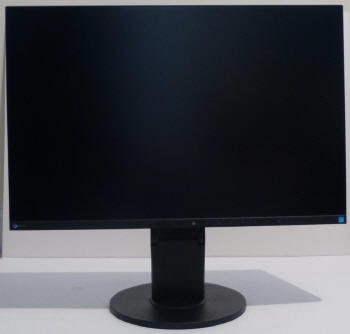
Above: front and back views of the screen. Click for larger versions
The EV2455 comes in an all-black design. Matte
plastics are used for the bezel, stand and base. The bezel is only 1mm
thin along the sides and top of the screen so is ultra-thin. There is also
then an additional 4.2m black border to the panel itself so the total edge
of the screen measures 5.2mm. The bottom bezel measures ~13mm. The screen
looks sleek and attractive thanks to this thin bezel design. There is a
small Eizo logo in the bottom left hand corner, but no model designation
to be seen.
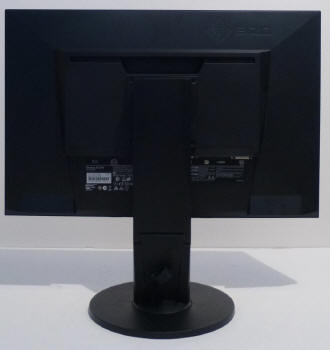
The back of the screen is again a matte
black plastic finish. There is a useful carry handle at the top of the
stand attachment.
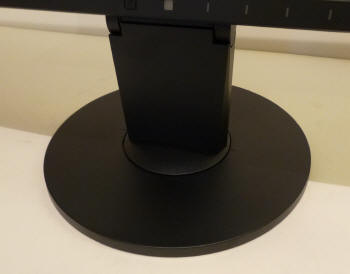
Above: view of the circular base of the stand. Click for larger version
The base of the stand is circular and again a
matte black plastic. It provides a sturdy base for the screen and it does
not wobble much at all which is pleasing.
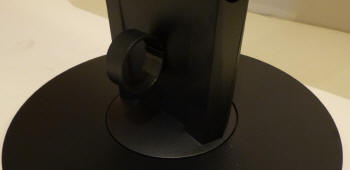
Above: cable tidy on the back of the stand. Click for larger version
On the back of the stand is a cable tidy
clip as shown above.


The stand offers a full range of ergonomic
adjustments as listed above.
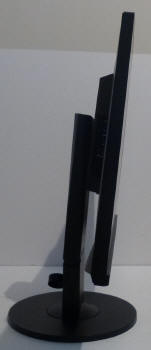
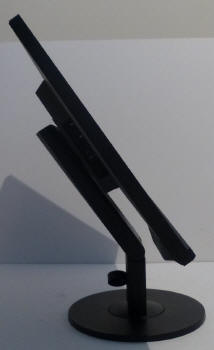
Above: full tilt adjustment range shown. Click for larger versions
The tilt adjustment is actually operated by a
hinge in the arm itself as you can see above. As a result of this, it is
very stiff to move and you really do need to grab the screen by both hands
near the top and push backwards. It's not as easy to tilt as some other
stands we've seen in the past which is a shame. The range of adjustment is
excellent though as you can see.
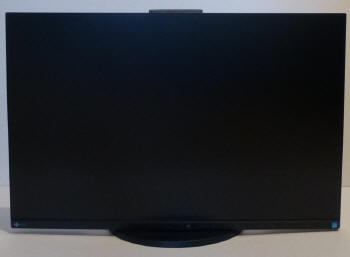
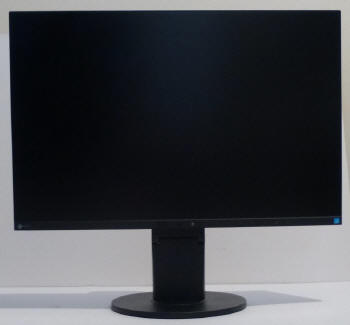
Above: full height adjustment range shown. Click for larger versions
The height adjustment is a bit easier to move, but
not much. It's still pretty stiff to operate but again provides a decent
range of adjustment (130mm total). At the lowest setting the bottom edge
of the screen basically touches the base of the stand, leaving it ~15mm
from the edge of the desk. At it's maximum adjustment range it is ~145mm
from the edge of the desk. When it is at its lowest, you can actually see
the top of the stand behind the screen as shown in the first photo above.
The spec from Eizo lists a height adjustment range of 140mm as it is the same
stand as used on the EV2450. However, because the screen is a little bigger
vertically, and at the lowest setting it is basically limited by when the screen
touches the base of the stand, the full range of adjustment from the stand can't
be quite realised. So the total range (assuming a vertical screen angle) is
130mm here.
Side to side swivel is much easier and
smoother to use thankfully and offers a very wide range of movement.
Rotation is also provided to switch into portrait mode if you want, which
is reasonably smooth but a little stiff again to use.
A summary of the screens ergonomic adjustments
is shown below:
|
Function |
Range |
Smoothness |
Ease of Use |
|
Tilt |
-5 to 35° |
Smooth |
Very stiff |
|
Height |
130mm |
Smooth |
Quite stiff |
|
Swivel |
Yes |
Smooth |
Easy |
|
Rotate |
Yes |
Reasonable |
Stiff |
|
Overall |
Very good range of adjustments although some
are stiff, particularly tilt |
The materials were of a good standard and the
build quality felt good as well. There was no audible noise from the screen,
even when conducting specific tests which can often identify buzzing issues.
The whole screen remained very cool even during prolonged use as well which
was pleasing.

Above: interface connections on back of the screen
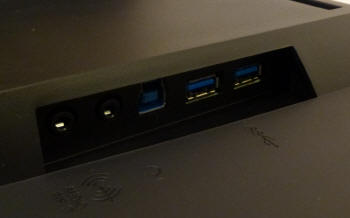
Above: USB interfaces and audio connections on the left hand back of the
screen. Click for larger version
The back of the screen features the 4 video
connections as shown above. There is also a normal kettle lead power socket
and an on/off switch on the back. The left hand edge of the back section of
the screen (as viewed from the front) features 2x USB 3.0 ports, 1x USB
upstream port and the audio in/out connections as shown above. These are
pretty easy to access and it's nice to see them included on the side part on
the back.

OSD Menu

Above: views of
OSD operational buttons on the bottom right hand edge of the screen
The OSD menu is controlled through a series of 6
touch-sensitive buttons located on the front edge of the lower bezel. They are
marked by 6 small vertical grey strips, but they do not light up. There is also
a touch-sensitive power on/off button located to the right of these as shown in
the photo above and next to that is the power LED. This glows white during
normal operation and amber in standby. You will notice on the left hand edge
there is the human motion sensor and ambient light sensor as well.

Pressing any of the buttons brings up the quick
access menu shown above, with each option aligned above the relevant button on
the bottom of the screen display.
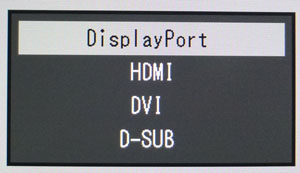
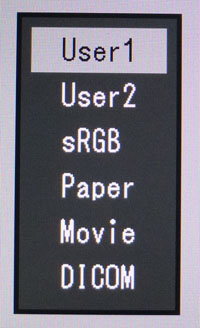
The input selection allows you to quickly switch
between the 4 interfaces. The 'mode' menu gives you quick access to the preset
mode menu.


The sound and brightness quick launch options are
shown above and pop up a small scrolling bar for you to make quick and easy
adjustments.
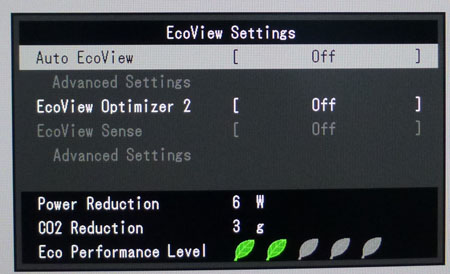
The 'ECO' menu contains all the Eco saving options
including the Auto EcoView ambient light sensor and EcoView Sense human motion
sensor. These are not listed within the main OSD so you need to access them via
the quick launch if you want to turn them on or off.
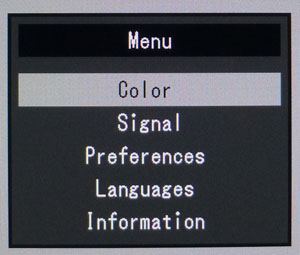
The main OSD menu is accessed using the 'menu'
option. Initially you are presented with 5 sections as shown above.
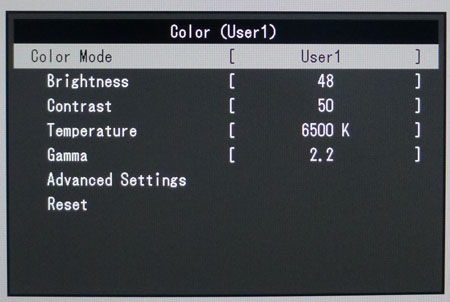
The first 'Color' section contains most of the
options you will probably want to play with. You can change the preset mode,
brightness, contrast, colour temperature and gamma modes here. There is a
further 'advanced settings' sub-section which we will talk about below.
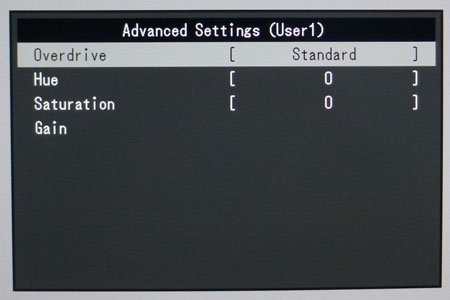
The 'advanced settings' sub-section contains the
option for the pixel
response time
/ overdrive setting as well as allowing you to adjust the RGB channels if you
need to for
calibration.
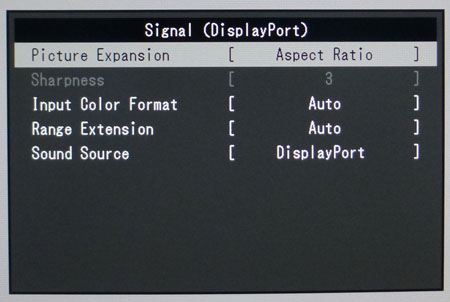
The signal menu contains a few options related to
the video input. There are options for hardware aspect ratio control here, with
'full screen', 'aspect ratio' and 'dot by dot' (1:1 pixel mapping) options
available.
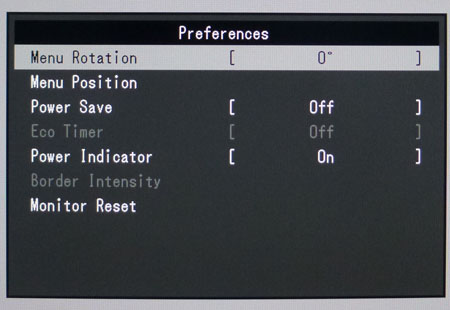
The preferences section allows you to control a
few things relating to the menu itself and also the power LED.
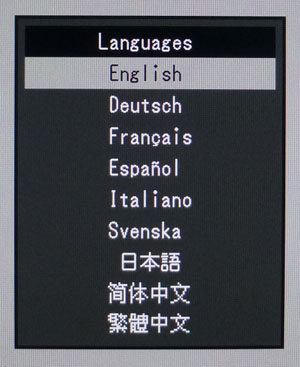
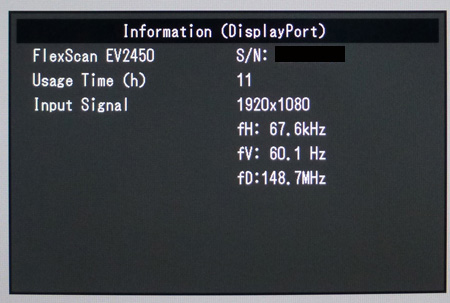
The languages and information sections are shown
above. For the eagle-eyed, the information section photo is actually from the
EV2450. It's the exact same thing on the EV2455 but the resolution would say
1920 x 1200.
All in all the menu navigation was quick and easy,
and the software seemed responsive. It was pretty intuitive as well, although
the software maybe looked a little dated and simplistic. There are enough
options to play so no real complaints here.

Power Consumption
In terms of power consumption the manufacturer
lists 13W typical usage, 49W maximum usage and <0.3W in standby. We carried out our normal tests to
establish its power consumption ourselves.
|
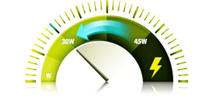 |
|
State and Brightness
Setting |
Manufacturer Spec (W) |
Measured Power Usage
(W) |
|
Factory Default (100%) |
- |
23.1 |
|
Calibrated (32%) |
- |
12.5 |
|
Maximum Brightness (100%) |
49.0 |
23.1 |
|
Minimum Brightness (0%) |
- |
7.8 |
|
Standby |
<0.3 |
0.5 |
|
We tested this ourselves and found that out of the
box the screen used 23.1W at the default 100% brightness setting. This was once
the ambient light sensor feature had been disabled. Maximum usage specified
would presumably be with USB connected etc as well. Once calibrated the screen reached
12.5 W consumption, and in standby it used only 0.6W. Pretty much the same as
the EV2450 really as to be expected given the similarities in hardware and
features. We have plotted these
results below compared with other screens we have tested:


Panel and Backlighting
|
Panel Manufacturer |
LG.Display |
Colour Palette |
16.7 million |
|
Panel Technology |
AH-IPS |
Colour Depth |
6-bit + FRC |
|
Panel Module |
LM240WUA-SSA1 |
Colour space |
Standard gamut |
|
Backlighting Type |
W-LED |
Colour space coverage (%) |
~sRGB, 72% NTSC |
Panel Part and Colour Depth
The Eizo EV2455 is built on an
LG.Display LM240WUA-SSA1 AH-IPS panel which is capable of producing 16.7
million colours. We have not been able to verify via the panel spec sheet as to
whether this is a true 8-bit module or a 6-bit + FRC panel, but we expect the
latter given most of the current standard gamut IPS panels used today are
6-bit+FRC, especially in this size range. This is a measure commonly taken on
modern IPS panels, and the FRC algorithm is very well implemented to the point
that you'd be very hard pressed to tell any difference in practice compared with
an 8-bit panel. The panel is confirmed when dismantling the screen and is the
exact same panel used in the
Dell U2415:
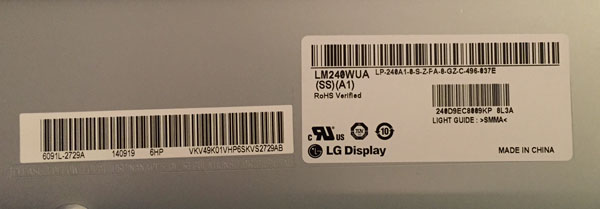
Screen
Coating
The
screen coating on the EV2455 is much like that featured on other recent IPS screens
and the same as that on the EV2450, and the Dell U2415 of course which is using
the same panel. It is a normal anti-glare (AG) offering as opposed to any kind of glossy
coating. However, this is contrary to a lot of other older IPS based screens
which usually feature a grainy and aggressive solution. Instead it is a light AG
coating which retains its anti-glare properties to avoid unwanted reflections,
but does not produce an overly grainy or dirty image. It's not a full
semi-glossy appearance like some screens but it is nice and light. There was no
sign of any cross-hatching patterns on the coating.
Backlight Type and Colour Gamut
The screen uses a White-LED (W-LED) backlight unit
which has become very popular in today's market. This helps reduce power
consumption compared with older CCFL backlight units and brings about some
environmental benefits as well. The W-LED unit offers a standard colour gamut
which is approximately equal to the sRGB colour space, and equating to ~72%
NTSC. Anyone wanting to work with wider colour spaces would need to consider
wide gamut CCFL screens, or perhaps the new range of GB-r-LED displays
available.
Backlight
Dimming and Flicker
We tested the screen to establish the methods used
to control backlight dimming. Our in depth article talks in more details about a
common method used for this which is called
Pulse Width Modulation (PWM). This in itself gives cause for concern to some
users who have experienced eye strain, headaches and other symptoms as a result
of the flickering backlight caused by this technology. We use a photosensor +
oscilloscope system to measure backlight dimming control
with a high level of accuracy and ease. These tests allow us to establish
1) Whether PWM is being used to control the
backlight
2) The frequency and other characteristics at which this operates, if it is used
3) Whether a flicker may be introduced or potentially noticeable at certain
settings
If PWM is used for backlight dimming, the higher
the frequency, the less likely you are to see artefacts and flicker. The duty
cycle (the time for which the backlight is on) is also important and the shorter
the duty cycle, the more potential there is that you may see flicker. The other
factor which can influence flicker is the amplitude of the PWM, measuring the
difference in brightness output between the 'on' and 'off' states. Please
remember that not every user would notice a flicker from a backlight using PWM,
but it is something to be wary of. It is also a hard thing to quantify as it is
very subjective when talking about whether a user may or may not experience the
side effects.
100%
50%
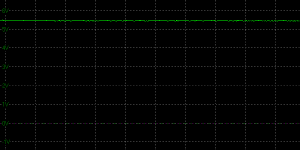
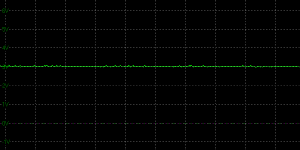
10%
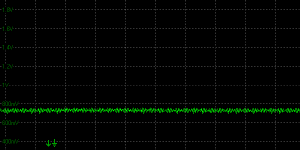
Above scale = 1
horizontal grid = 1ms
10% Zoomed
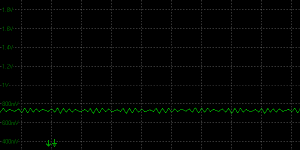
Above scale = 1
horizontal grid = 0.25ms
At 100% brightness a constant voltage is applied
to the backlight as you would expect. As you reduce the brightness setting a
Direct Current (DC) method is used for backlight dimming between settings of 100
and 20. From 20 downwards there is a very high frequency oscillation introduced,
but it is not a full amplitude PWM on/off switching. This oscillation is of such
a high frequency (18,000Hz) and such a low amplitude that it is unlikely to
introduce issues for most users. Eizo refer to this backlight dimming technique
as their "hybrid" system, although we were pleased that for brightness of 20 and
below it was not the usual full PWM switching as we've seen on other EV models
in the past. This was the same backlight control as we'd seen from the EV2450
16:9 aspect model.
|
Pulse Width
Modulation Used |
Hybrid |
|
Cycling
Frequency |
100 - 20% = n/a
20 - 0% = 18,000Hz low amplitude oscillation only |
|
Possible
Flicker at |
|
|
100% Brightness |
No |
|
50% Brightness |
No |
|
20% Brightness |
No |
|
19% Brightness |
Yes |
|
0% Brightness |
Yes |
For an up to date list of all flicker-free (PWM free) monitors please see our
Flicker Free Monitor Database.

Contrast
Stability and Brightness
We wanted to see how much variance there was in
the screens contrast as we adjusted the monitor setting for brightness.
In theory, brightness and contrast are two independent parameters, and good
contrast is a requirement regardless of the brightness adjustment.
Unfortunately, such is not always the case in practice. We recorded the
screens luminance and black depth at various OSD brightness settings, and
calculated the contrast ratio from there. Graphics card settings were left at
default with no ICC profile or calibration active. Tests were made using an
X-rite i1 Display Pro colorimeter. It should be noted that we used the
BasICColor calibration software here to record these, and so luminance at
default settings may vary a little from the LaCie Blue Eye Pro report.
|
OSD
Brightness |
Luminance
(cd/m2) |
Black
Point (cd/m2) |
Contrast
Ratio
( x:1) |
|
100 |
321.47 |
0.38 |
846 |
|
90 |
294.91 |
0.34 |
867 |
|
80 |
266.68 |
0.30 |
889 |
|
70 |
236.87 |
0.27 |
877 |
|
60 |
207.31 |
0.23 |
901 |
|
50 |
175.53 |
0.20 |
878 |
|
40 |
143.36 |
0.16 |
896 |
|
30 |
110.87 |
0.12 |
924 |
|
20 |
76.30 |
0.09 |
848 |
|
10 |
39.65 |
0.04 |
991 |
|
0 |
0.68 |
<0.02 |
- |
|
Total Luminance Adjustment Range
(cd/m2) |
320.79 |
Brightness OSD setting controls backlight? |
 |
|
Total Black Point
Adjustment Range (cd/m2) |
>0.36 |
|
Average Static Contrast Ratio |
892:1 |
PWM Free? |
Hybrid |
|
Recommended OSD setting for 120 cd/m2 |
33 |
The brightness control gave us a very good range
of adjustment. At the top end the maximum luminance reached 321.47
cd/m2 which was
slightly higher even than the specified maximum brightness of 300 cd/m2 by the
manufacturer. There was a 320.79 cd/m2 adjustment range in total, and
so at the minimum setting you could reach down to an incredibly low luminance of
0.68 cd/m2. We're not sure why it can go all this low as it's not
really usable at that brightness, but basically Eizo have allowed a full range
of the backlight here from on to off pretty much. This should be more than
adequate for those wanting to work in darkened room conditions with low ambient
light. A setting of ~33 in the OSD menu should return you a
luminance of around 120 cd/m2 at default settings.
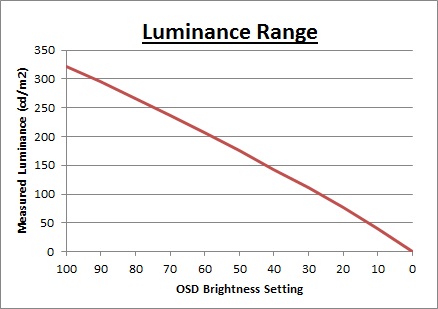
We have plotted the
luminance trend on the graph above. The screen behaves as it should in this
regard, with a reduction in the luminance output of the screen controlled by the
reduction in the OSD brightness setting. This was pretty much a linear relationship
as you can see from the shape of the graph. It should be noted also that the brightness regulation is controlled by
a Direct Current (DC) method instead of using
Pulse Width Modulation for settings between 100 and 20. From 20 and below a very low amplitude, and
very high frequency (18,000Hz) oscillation is introduced which should not cause
any problems for most users. You can reach down to a luminance of around 76 cd/m2
anyway before you even need to enter the zone where the oscillation is present.
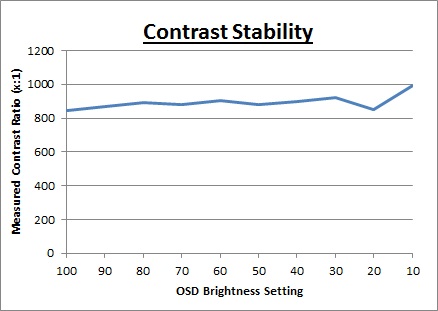
The average contrast ratio of
the screen was 892:1. It did fluctuate a bit across the brightness adjustment
range. At the highest brightness settings the contrast was nearer to 850:1,
while at the lower settings it reached over 950:1 in some cases. At the
brightness settings you're more like to use day to day, the contrast ratio was
stronger which was good news.

Testing
Methodology
An
important thing to consider for most users is how a screen will perform out of
the box and with some basic manual adjustments. Since most users won't have
access to hardware colorimeter tools, it is important to understand how the
screen is going to perform in terms of colour accuracy for the average user.
I
restored my graphics card to default settings and disabled any previously active
ICC profiles and gamma corrections. The screen was tested at default factory settings using the DVI interface, and analysed using
an
X-rite i1
Pro Spectrophotometer (not to be confused with the i1 Display Pro
colorimeter) combined with
LaCie's Blue Eye Pro software suite. An X-rite i1 Display Pro colorimeter was
also used to verify the black point and contrast ratio since the i1 Pro
spectrophotometer is less
reliable at the darker end.
Targets for these tests are as follows:
-
CIE Diagram - validates the colour space
covered by the monitors backlighting in a 2D view, with the black triangle representing the
displays gamut, and other reference colour spaces shown for comparison
-
Gamma - we aim for 2.2 which is the default
for computer monitors
-
Colour temperature / white point - we aim
for 6500k which is the temperature of daylight
-
Luminance - we aim for 120
cd/m2, which is
the recommended luminance for LCD monitors in normal lighting conditions
-
Black depth - we aim
for as low as possible to maximise shadow detail and to offer us the best
contrast ratio
-
Contrast ratio - we aim
for as high as possible. Any dynamic contrast ratio controls are turned off here
if present
-
dE average / maximum -
as low as possible.
If DeltaE >3, the color displayed is significantly different from the
theoretical one, meaning that the difference will be perceptible to the
viewer.
If DeltaE <2, LaCie considers the calibration a success; there remains a
slight difference, but it is barely undetectable.
If DeltaE < 1, the color fidelity is excellent.

Default Performance and
Setup
Default settings of the screen were as follows. It should be noted that we
disabled all EcoView settings where brightness of the screen is controlled based
on ambient lighting conditions.
|
Monitor OSD Option |
Default Settings |
|
Brightness |
100 |
|
Contrast |
50 |
|
Preset mode |
User 1 |
|
RGB |
96, 98, 100 (default) |
|
Color Temperature |
6500k |
|
Gamma |
2.2 |

Eizo EV2455 - Default Factory Settings




|
|
Default Settings |
|
luminance (cd/m2) |
325 |
|
Black Point (cd/m2) |
0.38 |
|
Contrast Ratio |
846:1 |
Out of the box the screen looked good to
the naked eye. Colours felt even and well balanced, and the only thing which
felt off was the very bright backlight as brightness was maxed out at 100. We went ahead and measured
the default state with the i1 Pro.

The
CIE diagram on the left of the image confirms that the monitors colour gamut
(black triangle) matches the sRGB colour space very well, with some slight
over-coverage in blue and red shades. Default
gamma was recorded at 2.2 average, leaving it with a very minor 1% deviance from
the target of 2.2. White point was measured at 6392k leaving it a small 2% out
from our target of 6500k which was very pleasing. This was very similar to what
we'd seen from the EV2450 model as well.
Luminance was recorded at a very bright 325
cd/m2 which is
too high for prolonged general use. The screen was set at a default 100%
brightness once you disabled the EcoView modes in the OSD menu but that is easy
to change of course to reach a more comfortable setting. The black depth was
0.38 cd/m2 at this default
brightness setting, giving us a good (for an IPS panel) static contrast ratio of
846:1.
Colour accuracy was very good too out of the
box with a default dE average of 1.8, and maximum of 4.7. Testing the screen with
various gradients showed smooth transitions with no sign of any banding
thankfully. There was some very slight gradation evident in darker tones as you
will see from most monitors and if you looked very closely you could pick out
some twinkling from the Frame Rate Control. Not something you'd see in normal
use though at all. Overall the default setup was very good and we were
impressed. The contrast ratio was slightly lower than we had expected but it was
still good for an IPS-type panel.

Calibration
We used the
X-rite i1 Pro spectrophotometer combined with the LaCie Blue Eye Pro
software package to achieve these results and reports. An X-rite i1 Display Pro
colorimeter was used to validate the black depth and contrast
ratios due to lower end limitations of the i1 Pro device.
|
Monitor OSD Option |
Calibrated Settings |
|
Brightness |
32 |
|
Contrast |
50 |
|
Preset mode |
User 1 |
|
RGB |
96, 98, 99 |
|
Color Temperature |
6500k |
|
Gamma |
2.2 |

Eizo EV2455 - Calibrated Settings
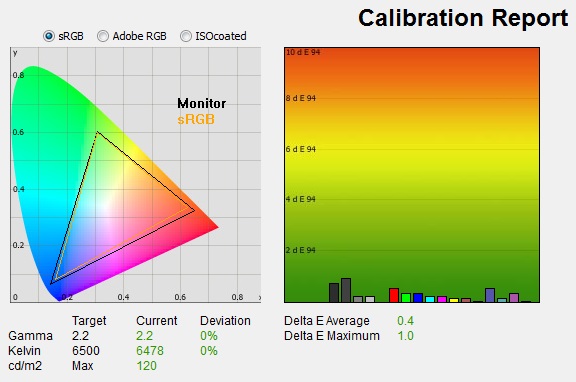
|
|
Calibrated Settings |
|
luminance (cd/m2) |
120 |
|
Black Point (cd/m2) |
0.12 |
|
Contrast Ratio |
1032:1 |
We stuck with the 'user1' preset
mode in the OSD menu which allowed us access to the individual RGB channels. Adjustments were made during the process to the RGB channels as shown in the table above
as well as the brightness control. This allowed us to obtain an
optimum hardware starting point and setup before software level changes would be
made at the graphics card level.
We left the LaCie software to calibrate to "max"
brightness which would just retain the luminance of whatever brightness we'd set
the screen to, and would not in any way try and alter the luminance at the
graphics card level, which can reduce contrast ratio. These adjustments before
profiling the screen would help preserve tonal values and limit banding issues.
After this we let the software carry out the LUT adjustments and create an
ICC profile.

Average gamma had been corrected more closely to
the desired 2.2 average, correcting
the minor 1% deviance we'd
found out of the box which was good. The white point was adjusted to 6478k,
correcting the minor 2% deviance we'd seen before as well. Luminance had also
been improved thanks to the adjustment to the brightness control and was now
being measured at 120
cd/m2.
This left us a black depth of 0.12 cd/m2 and an excellent (for an IPS
panel) static contrast ratio of 1032:1. Colour
accuracy had been corrected nicely also, with dE average of 0.4 and maximum of
1.0. Although to be honest it was good out of the box anyway. LaCie would consider colour fidelity to be excellent.
Testing the screen with various colour gradients
showed smooth transitions. There was some very slight gradation in darker tones
but no banding was introduced which can often happen where adjustments are made to the
graphics card LUT from the profilation of the screen.
You can use our settings and
try our calibrated ICC profile if you wish, which are available in
our ICC profile database. Keep in mind that results will vary from one
screen to another and from one computer / graphics card to another.

Calibration
Performance Comparisons
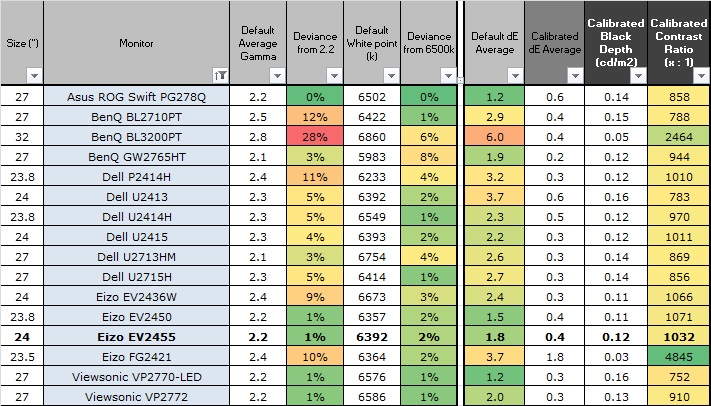
The comparisons made in this section try to give
you a better view of how each screen performs, particularly out of the box which
is what is going to matter to most consumers. When comparing the default factory
settings for each monitor it is important to take into account several
measurement areas - gamma, white point and colour accuracy. There's no point
having a low dE colour accuracy figure if the gamma curve is way off for
instance. A good factory calibration requires all 3 to be well set up. We have
deliberately not included luminance in this comparison since this is normally
far too high by default on every screen. However, that is very easily controlled
through the brightness setting (on most screens) and should not impact the other
areas being measured anyway. It is easy enough to obtain a suitable luminance
for your working conditions and individual preferences, but a reliable factory
setup in gamma, white point and colour accuracy is important and not as easy to
change accurately without a calibration tool.
From these comparisons we can also compare the
calibrated colour accuracy, black depth and contrast ratio. After a calibration
the gamma, white point and luminance should all be at their desired targets.
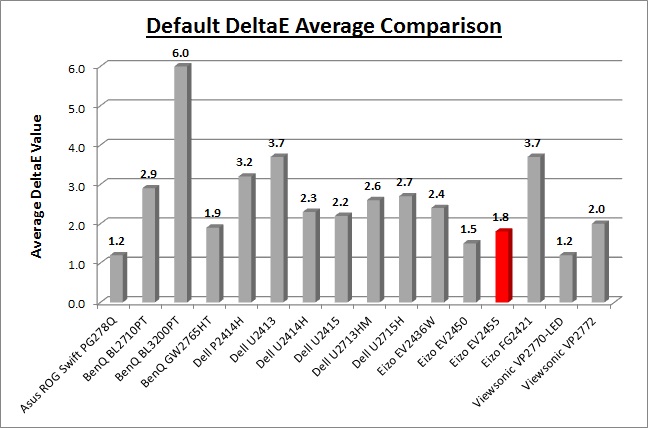
Default setup of the screen was very good overall,
and should be perfectly fine for most users. There was only a very minor deviance in the
desired gamma and white point, with a 1% and 2% error respectively which was
very good. Colour accuracy was very good as well at 1.8 average dE. We can
compare the EV2455 to the 16:9 format EV2450 as well, which had a very similar
default setup.
Also comparing the EV2455 to its most logical competitor, the Dell
U2415, the Eizo had a slightly more accurate gamma by default and slightly
better colour accuracy.
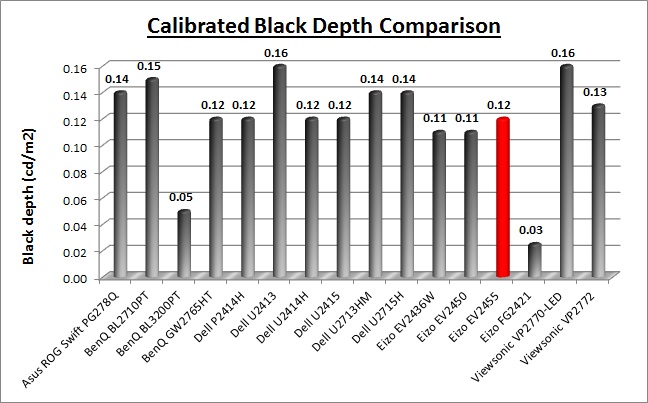
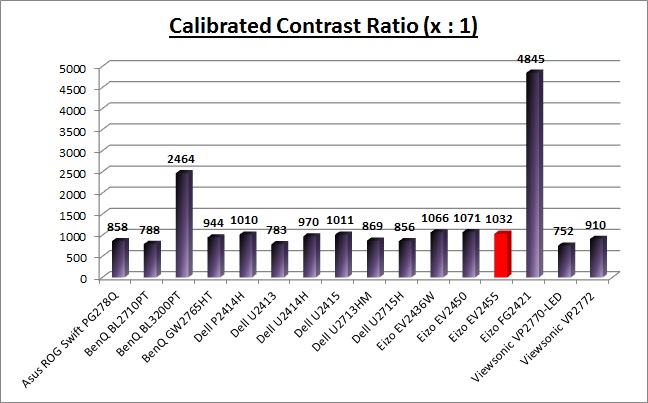
The panel did well in terms of black depth and
contrast ratio for an IPS matrix once calibrated and when we'd switched to a
lower brightness setting. It had a calibrated contrast ratio of 1032:1
measured. This couldn't compete with some of the VA based screens we've tested
which could reach up to 2000 - 3000:1 static contrast ratios easily (e.g. BenQ
BL3200PT, 2464:1). Some, like
the Eizo Foris FG2421's MVA panel reached even higher up to 4845:1. For an IPS
panel it was one of the best we have tested, out-performing some of the other
strong IPS panel contrast ratios like the Dell U2415 (1011:1) for instance ever
so slightly.

Viewing Angles
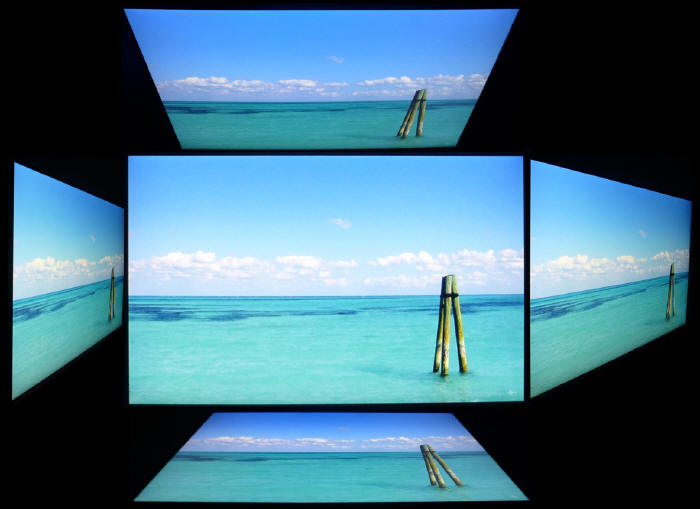
Above: Viewing
angles shown from front and side, and from above and below. Click for
larger image
Viewing angles of the EV2455 were very
good as you would expect from an IPS panel. Horizontally there was very little
colour tone shift until wide angles past about 45°. A slight darkening of the
image occurred horizontally from wider angles as you can see above as the
contrast shifted slighting. Contrast shifts were slightly more noticeable in the
vertical field but overall they were very good. The screen
offered the wide viewing angles of IPS technology and was free from the restrictive fields of view of TN Film panels, especially in the vertical plane.
It was also free of the off-centre contrast shift you see from VA panels and a
lot of the quite obvious gamma and colour tone shift you see from some of the
modern AMVA and PVA offerings. All as expected really from a modern IPS panel.
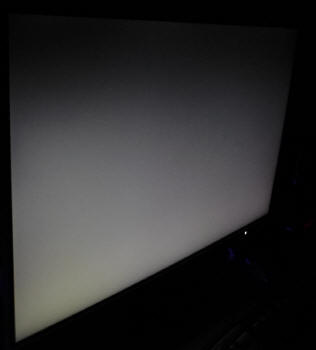
Above: View of an
all black screen from the side. Click for larger version
On a black image there was a slight white glow
from an angle which can be problematic on some IPS panels. If you are working in
darkened room conditions and with dark content on the screen this may prove
difficult. As you change your line of sight the white, silvery glow appears
across the panel. This is not so much of a problem on a smaller 24" screen than
it might be on some of the larger displays available today, but could still be
distracting if you work with a lot of dark content. The IPS-glow was more
pronounced than we had seen from the
EV2450, which had impressed us with is "low glow" IPS panel. On the EV2455
it was pretty standard for an IPS panel. This was the same pattern we'd seen
between the low glow Dell U2414H (16:9) and the normal glow U2415 (16:10
aspect).

Panel Uniformity
We wanted to test
here how uniform the brightness was across the screen, as well as identify any
leakage from the backlight in dark lighting conditions. Measurements of the
luminance were taken at 35 points across the panel on a pure
white background. The measurements were taken using BasICColor's calibration
software package, combined with an X-rite i1 Display Pro
colorimeter with a central point on the screen calibrated to 120 cd/m2. The below uniformity diagram shows the difference, as a percentage,
between the measurement recorded at each point on the screen, as compared with the
central reference point.
It is worth
noting that panel uniformity can vary from one screen to another, and can depend
on manufacturing lines, screen transport and other local factors. This is only a
guide of the uniformity of the sample screen we have for review.

Uniformity of Luminance
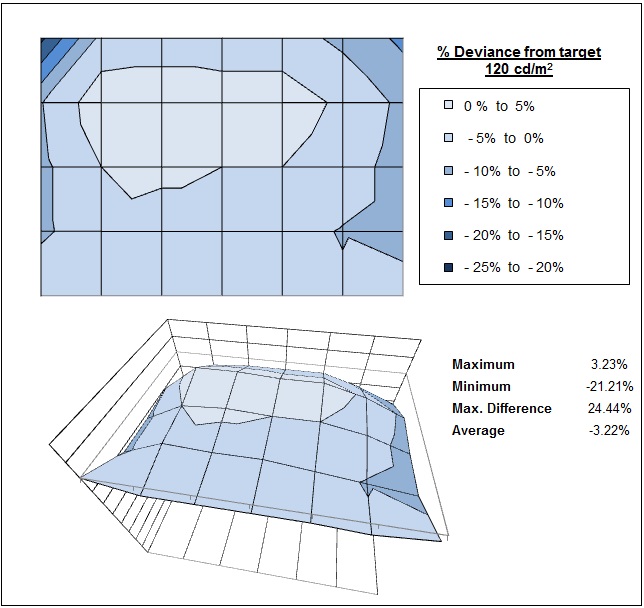
The luminance uniformity of the screen was
excellent overall. The very top left hand corner showed the only significant
drop in luminance where it ranged down to 99
cd/m2
as a minimum (-21.21%). The right hand edge was also a little darker than
the rest of the screen but only by around 6 - 7%. Around 94% of the screen
was within a 10% deviance from the centrally calibrated point which was very
good.

Backlight Leakage
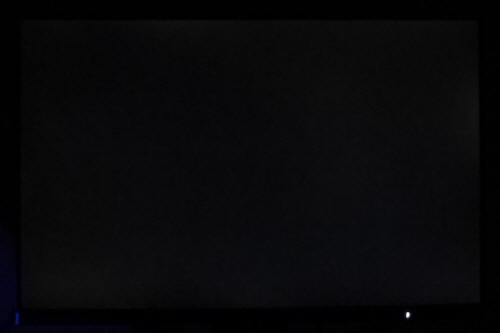
Above: All black screen in a darkened room. Click for larger version
As usual we also tested the screen with an all
black image and in a darkened room. A camera was used to capture the result.
Three was some slight clouding in the bottom left corner and along the right
hand edge of the screen but
nothing too severe at all, and certainly nothing you could spot during normal uses day
to day.

General and Office Applications
The 1920 x 1200 resolution and 24.1" screen size
give a nice decent area in which to work and the vertical resolution is a little
more than the range of 16:9 aspect 24" models (1920 x 1080) out there in the
market. A lot of people prefer this extra vertical area and it is useful for
office applications we think. You may want to consider the fact that high
resolution 27" 2560 x 1440 models are becoming increasingly available and so the
difference in desktop size is certainly noticeable coming from a 27" screen like
that. Nevertheless, the 24" 1920 x 1200 resolution should be adequate for many
users. The screen offered a comfortable 0.27mm pixel pitch which delivered easy
to read text at a nice size, in our opinion. The resolution is big enough for
side by side split screen working as well in many cases although we do find that
nowadays a lot of web content needs more than half a screen (i.e. wider than 960
pixels).
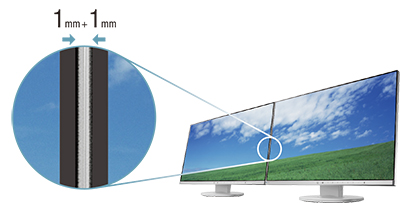
The ultra-thin bezel design is ideal for multi
screen setups with a very small plastic border around the edge of the screen.
You do need to account for the black panel border as well of course, but
nevertheless the edges are very thin here and one of the key selling points.
The light AG coating of the new style AH-IPS panel is
certainly welcome, and a very positive change from the older grainy and 'dirty'
appearance of older IPS AG coatings. The
wide viewing
angles provided by the IPS panel technology on both horizontal and vertical
planes, helps minimize on-screen colour shift when viewed from different angles.
The
default setup of the screen was very good in all areas, with only brightness
needing to be turned down to something more comfortable (which doesn't affect
other aspects of the setup). The contrast
ratio was good out of the box for an IPS panel at 846:1 and actually even better
when you lowered the brightness down to a more comfortable level. After
calibration we had improved contrast ratio slightly more to 1032:1 which was
excellent for an IPS panel.
The brightness
range of the screen was also very good, with the ability to offer a luminance
between 321 and 0.7 cd/m2. This should mean the screen is perfectly
useable in a wide variety of ambient light conditions, including darkened rooms.
A setting of ~33 in the OSD brightness
control should return you a luminance close to 120 cd/m2 out of the
box. On another
positive note, the brightness regulation is controlled without the need for the use of
the now
infamous
Pulse-Width Modulation (PWM), for settings between 100 and 20. From 20 and
below a very low amplitude and very high frequency oscillation is introduced
which is unlikely to cause many issues at all. You can reach a nice low
luminance of around 76 cd/m2 anyway before you even need to drop brightness below
20. Those who suffer from eye fatigue or headaches associated
with flickering backlights need not worry.
There was no
audible noise or buzzing from the screen, even when specifically looking for it
using test images with a large amount of text at once. The screen also remains
cool even during prolonged use. There is a 'paper' preset mode available from the
menu which may be useful if you want to set up the screen for different uses
perhaps and made the image far more yellow.
The screen offers 2x USB 3.0 ports which can be
useful and it was nice to keep this up to date with the modern version. There are
also some further
extras including a useful ambient light sensor and human motion sensor. These
are particularly useful in office environments and nice features we felt. The
motion sensor is handy to switch the screen on and off when it detects you have
left your desk, and the ambient light sensor can help you achieve comfortable
brightness levels for varying ambient light conditions. The rival Dell U2415 didn't
have these features so this was certainly a win for the Eizo model.
There
are also some basic 2x 1W stereo speakers and associated audio input/output
connections which might be useful to some people. They aren't up to much when it
comes to gaming or movies, but should be fine for the odd mp3 or video clip.
There was a decent range of ergonomic adjustments available from the stand
allowing you to obtain a comfortable position for a wide variety of angles. The
tilt function was pretty stiff and hard to operate though so could have been
better. The
VESA mounting support may also be useful to some people as well.
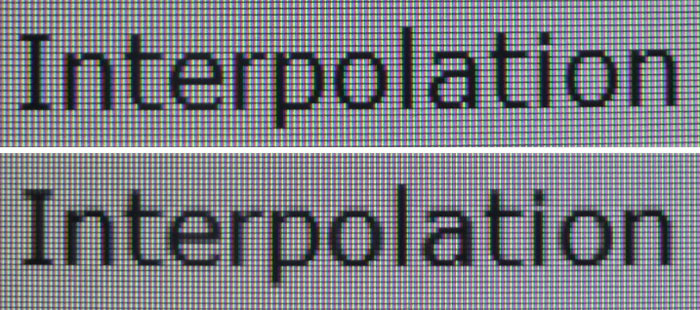
Above: photo of
text at 1920 x 1200 (top) and 1680 x 1050 (bottom)
The screen is designed to run at its native
resolution of 1920 x 1200 and at a 60Hz recommended refresh rate. However, if
you want you are able to run the screen outside of this resolution. We tested
the screen at a lower 1680 x 1050 resolution to see how the screen handles the
interpolation of the resolution, while maintaining the same aspect ratio of
16:10. At native resolution the text was very sharp and comfortable as we've
already discussed. When running at a 1680 x 1050 resolution the text is still
pretty sharp, with low levels of blurring. You do lose some screen real-estate
as well of course.

Responsiveness and Gaming
|
Quoted G2G Response Time |
5ms G2G |
|
Quoted ISO Response Time |
n/a |
|
Panel Manufacturer and
Technology |
LG.Display AH-IPS |
|
Panel Part |
LM240WUA-SSA1 |
|
Overdrive Used |
Yes |
|
Overdrive Control Available to
User |
'Overdrive' |
|
Overdrive Settings |
Off, Standard, Enhanced |
The EV2455 is rated by Eizo as having a 5 ms G2G response time
and the panel uses
overdrive /
response time compensation (RTC) technology to boost pixel transitions
across grey to grey changes. There is a user control over the overdrive impulse
within the OSD menu in the advanced setting section of the 'color' menu, with
options for off, standard and enhanced available to choose from. The
part
being used is the
LG.Display LM240WUA-SSA1 AH-IPS panel. Have a read about response time in
our
specs section if you need additional information about this measurement.
We will first test the screen using our thorough
response time testing method. This uses an oscilloscope and photosensor to
measure the pixel response times across a series of 20 different transitions, in
the full range from 0 (black) to 255 (white). This will give us a realistic view
of how the monitor performs in real life, as opposed to being reliant only on a
manufacturers spec. We can work out the response times for changing between many
different shades, calculate the maximum, minimum and average grey
to grey (G2G) response times, and provide an evaluation of any overshoot present
on the monitor.
We use an
ETC M526
oscilloscope for these measurements along with a custom photosensor device.
Have a read of
our response time measurement article for a full explanation of the testing methodology and reported
data.
Response Time Setting Comparison (Overdrive
option)

The EV2455 comes with a user control for the
overdrive impulse available within the OSD menu in the advanced settings section
of the 'color' menu as shown above. There are three options under the
'Overdrive' setting. First of all we carried out a smaller sample set of
measurements in all three of the settings. These, along with various motion
tests allowed us to quickly identify which was the optimum setting for this
screen.

With the overdrive setting turned off, the pixel
transitions were very slow overall. There was an average 15.3ms G2G response
time measured which was slow and lead to noticeable blurring and ghosting of moving images.
With overdrive turned off there was at least no overshoot at all here.

Pushing the overdrive setting up to 'Standard'
brought about some obvious improvements. Response times were much better
although a little slow in some transitions. The average G2G response time was
now 9.5ms which was much better, although a little slower than some of the
fastest IPS-type panels we've tested so far. There was a little overshoot
introduced but not too much. This is certainly a better setting
to use than overdrive 'off'.

With overdrive pushed up to the maximum setting of
'enhanced' the response times were improved again, this time an average of 7.3ms
G2G was recorded. This would be very good for an IPS panel, had it not been for
the massive amounts of overshoot introduced as a result. This lead to noticeable
trailing and halos in moving images and so this mode should be avoided.
Incidentally not even this mode lived up to the specified 5ms G2G response time
which just goes to show you can't really trust some specs.
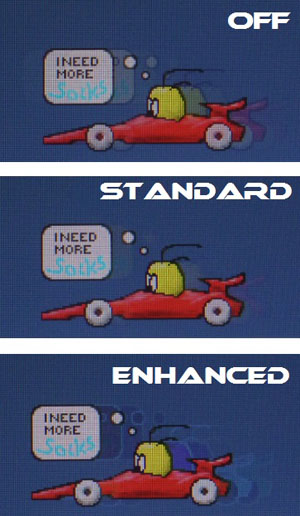
If we also carry out some subjective assessment of
the screen during gaming and with the use of the PixPerAn moving car tests, we
can also see the differences between each overdrive mode easily enough with the
naked eye. With overdrive off there was a noticeable blur to the moving image as
response times were slow. As you switch up to the 'standard' setting the blur is
reduced nicely and the moving object becomes much sharper and clearer. There is
still some blurring evident but no sign of any noticeable overshoot. When you
switch up to the 'enhanced' overdrive mode the blurring is reduced a fraction
more, but you can pick out some obvious overshoot in the test images, with both
dark and light halos introduced to a very noticeable degree. This confirms the
'standard' mode is optimum on this screen.
More Detailed Measurements - Overdrive Standard
Having established that the overdrive 'standard'
mode seemed to offer the best response/overshoot balance we carried out our
normal wider range of measurements as shown below:
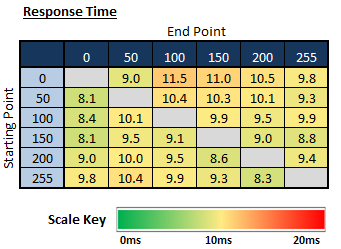
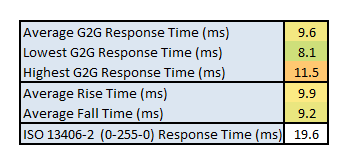
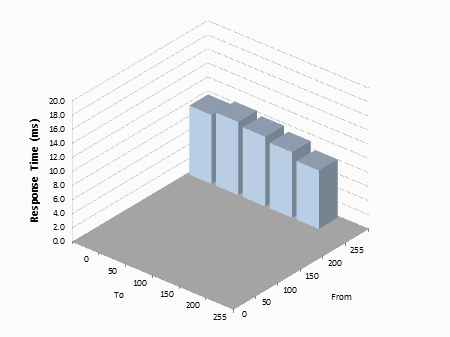
The average G2G response time was now more
accurately measured at 9.6 ms. Fall times were on average slightly faster (9.2ms)
than rise times (9.9ms) but overall the panel showed pretty consistent
transitions times across the range. This was reasonable for an IPS panel really.
It was ever so slightly faster than the EV2450 which had measured at 9.9ms G2G
average.
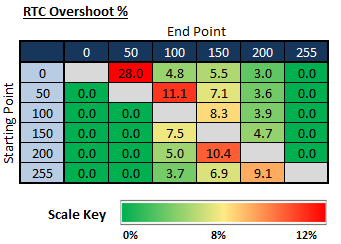
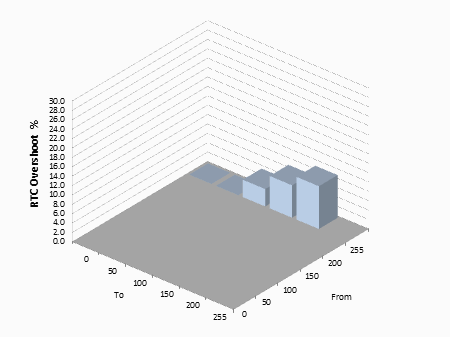
If we evaluate the Response Time Compensation
(RTC) overshoot then the results are pretty good but there are some transitions
which show some moderate to high overshoot. A couple of the measured transitions showed some overshoot,
mostly when changing between two very similar shades, more so if that
transition was getting slightly lighter. Overall we were pretty pleased with the result from the EV2455
and showed that this overdrive setting was not being too aggressive with the
overdrive impulse. It should be noted that the overshoot was slightly higher
than on the EV2450 model.
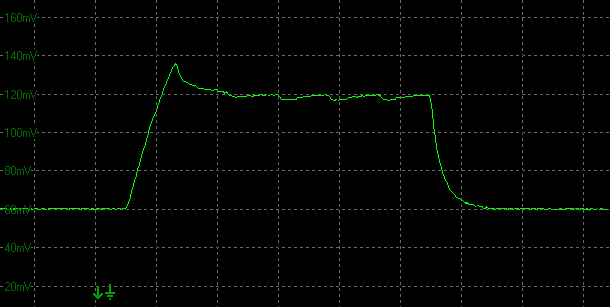
Transition: 0-50-0 (scale = 20ms)
As an example, the 0-50-0 transition is shown
above where you can see the largest recorded overshoot (28.0%) on the rise time.

Display Comparisons
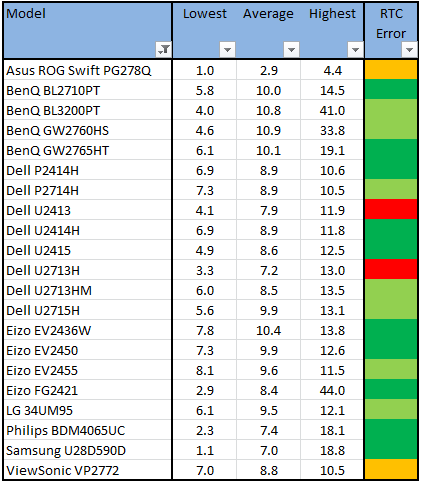
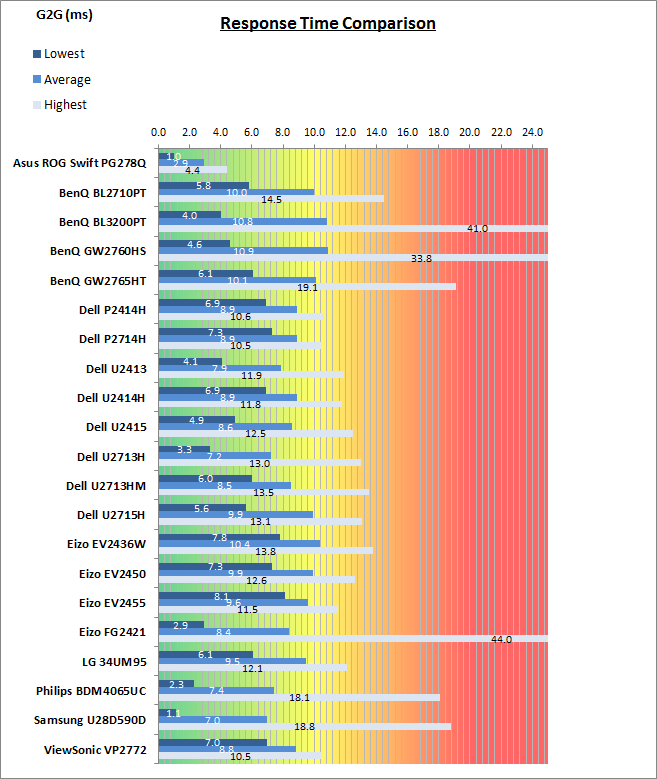
The above comparison table and graph shows you the
lowest, average and highest G2G response time measurement for a selection of
screens we have tested with our oscilloscope system. There is also a colour
coded mark next to each screen in the table to indicate the RTC overshoot error,
as the response time figure alone doesn't tell the whole story.
The response time performance of the EV2455 using
the 'standard' overdrive setting was pretty good overall for an IPS-type panel,
although not great. With an average G2G response time of 9.6 ms measured, it was
a little behind the fastest IPS models (where a massive amount of overshoot was
not introduced) like the Dell U2415 (8.6ms) and U2414H (8.9ms). Those models are
our reference point and represent about as good as you can get from modern IPS
response times without introducing a significant amount of overshoot. The EV2455
was very comparable to the EV2450 overall. Slightly faster on paper, but with a
slightly higher amount of overshoot detected. Some IPS-type models can reach lower response
times, like the
Dell U2713H for instance (7.2ms) but not without the cost of very high
overshoot. Modern TN Film panels are still much faster, reaching down to 2.9ms
for instance in the example of the new
Asus ROG Swift PG278Q (with moderate overshoot).
The screen was also tested using the chase test in
PixPerAn for the following display comparisons. As a reminder, a series of
pictures are taken on the highest shutter speed and compared, with the best case
example shown on the left, and worst case example on the right. This should only
be used as a rough guide to comparative responsiveness but is handy for a
comparison between different screens and technologies as well as a means to
compare those screens we tested before the introduction of our oscilloscope
method.

24" 5ms G2G
LG.Display AH-IPS (Overdrive = Standard)
In practice the Eizo EV2455 showed pretty low
levels of motion blur, and no obvious ghosting. There was some some slight
trailing in the best case images as you can see above but overall the movement
felt quite good. There was no sign of any major overshoot artefacts in these
tests either
which was pleasing. Of course you do need to keep in mind this is an IPS panel,
and so does not feel as snappy as a fast TN Film panel, and cannot offer the
response time of that panel technology either. Other limiting factors also come
into play including the refresh rate (limited to 60Hz here) and motion blur as a
result of eye-tracking and the way LCD monitors operate. For an IPS panel at
60Hz it is a decent result though.

24" 5ms G2G
LG.Display AH-IPS (Overdrive = Standard)

23.8" 5ms G2G
LG.Display AH-IPS (Overdrive = Standard)

23.8" 8ms G2G
LG.Display AH-IPS

23.8" 8ms G2G
LG.Display AH-IPS

24"
8ms
G2G LG.Display AH-IPS (Response Time = Normal)
We have provided a comparison of the EV2455 first
of all against a few recent screens we have tested, including the direct
alternative which is the Dell U2415. In practice these 5 models performed very
similarly to one another. We know from our oscilloscope measurements that the EV2455 is
slightly slower (9.6ms) by around 1ms G2G average than the fastest measured
which is the Dell U2415 (8.6ms), but in practice it's pretty hard to
separate them. Levels of blur were very comparable and none of these models had
any real noticeable overshoot which was pleasing. The overshoot was slightly
higher on the EV2455 than the other models shown above, but nothing major.

24" 5ms G2G
LG.Display AH-IPS (Overdrive = Standard)

27" 8ms G2G
LG.Display AH-IPS

27"
8ms G2G LG.Display AH-IPS (Response
Time = Normal)

27" 5ms G2G
Samsung PLS (Trace Free = 40)

27" 12ms G2G
Samsung PLS (Response Time = Advanced)
We have also provided a comparison of the
EV2455 above
against 4 popular 27" 2560 x 1440 res screens we have tested. The very
popular
Dell U2713HM
performed very similarly to the EV2455 in practice, showing pretty fast response
times and no noticeable overshoot. The
Asus PB278Q and
ViewSonic VP2770-LED
both feature PLS panels from Samsung, very similar overall to IPS but a
competing technology. Both were again pretty fast in these tests although in the
case of the Asus there was a small amount of overshoot introduced, but not much
at all while at the modest Trace Free setting of 40. The very recent
Dell U2715H was again very similar to the EV2455 overall. All in all the
Eizo EV2455 held its own against some of these fast IPS/PLS models.

24" 5ms G2G
LG.Display AH-IPS (Overdrive = Standard)

27" 2ms G2G Chi
Mei Innolux TN Film +144Hz (Trace Free = 60)

24" 2ms G2G AU
Optronics TN Film + 120Hz (AMA = On)

23.5" 4ms G2G
Sharp MVA + 120Hz
We've also included a comparison above against
3 very fast 120Hz+ compatible screens we have tested. The other screens shown
here are all aimed primarily at gamers and have various features and extras
which make them more suitable overall for gaming.
Firstly there is a comparison against the
Asus VG278HE with its 144Hz refresh
rate and fast response time TN Film panel. This showed very fast pixel response times and smooth movement thanks to
its increased refresh rate. You are able to reduce the motion blur even more
through the use of the LightBoost strobed backlight which we talked about in
depth in our article about
Motion Blur Reduction Backlights.
Then there is a comparison against the
BenQ XL2420T with another very fast TN Film panel and 120Hz refresh rate.
This showed very low levels of motion blur, but some dark overshoot was
introduced as a side-effect. Lastly there is the MVA based Eizo FG2421 screen
with a fast response time (especially for the panel technology being used) and
120Hz refresh rate support. There is also an additional 'Turbo 240' motion blur
reduction mode which really helps reduce the perceived motion blur in practice.
While these pixel response tests from PixPerAn show the
Dell to
have pretty fast pixel transitions and freedom from any overshoot, there is something else going on as well here which can't be picked out by the camera. All of these other
gaming models are
running at 120Hz (or higher) refresh rates, which allows for improved 120fps+ frame rates and
the support of
3D stereoscopic content as well. This can really help improve smoothness and
the overall gaming experience so these screens still have the edge when it comes
to fast gaming. Any additional extras to reduce perceived motion blur can also
have a real benefit in practical terms, and again not easy to pick out with this
camera method.

The responsiveness of the Eizo EV2455 was
pleasing, and only slightly behind the faster IPS and PLS models we have tested to
date. It was ever so slightly faster than the 16:9 format equivalent EV2450
model, but with slightly more overshoot as a result. Nothing really to separate
the two in practice to be honest. The competing Dell model, the U2415 was a little more
responsive but not by much.
The average 9.6ms G2G response time couldn't of course compete with fast
TN Film models, but for an IPS panel it was good. More pleasing perhaps,
certainly compared with many other screens was the freedom from
any overshoot problems. That can really be problematic in a whole variety of
uses, and so we were pleased Eizo hadn't tried to push the response time too far
at the expense of overshoot. The screen should be able to handle some fast
gaming without problem, although those wanting to play fast FPS or competitive
games may want to consider some of the more gamer orientated 120Hz+, TN Film
based compatible displays out
there, or perhaps something like the Eizo FG2421. Even better still would be models equipped with
LightBoost systems or other motion blur reduction backlights for optimum motion blur elimination.

Additional Gaming Features

Aspect Ratio Control - The screen offers
three options for hardware level aspect ratio control, available within the
'signal' section of the OSD menu. There are options for 'aspect ratio'
(which maintains the source aspect but fills as much of the screen as possible).
Then also 'full screen' (filling the screen no matter what the source aspect,
skewing it if necessary), and 'dot to dot' (1:1 pixel mapping). A good range of
options which should be all you need you would think, although note that oddly
when inputting a 1080p (1920 x 1080, 16:9 aspect ratio) source only the 'full'
option is available. This is confirmed in the Eizo user guide as well and seems
an odd choice. That means that if you input a 1080p games console or DVD player
it will be stretched vertically a bit to full the full 1920 x 1200 area. This
doesn't happen with 480p or 720p inputs, as the aspect ratio and dot to dot
options are available then.
These were much better options than provided on
the equivalent Dell U2415 display at least for those lower resolutions (but not
for 1080p). The Dell lacks any kind of 16:9 scaling support.
That can be problematic given the native 16:10 aspect of the display. There are
no 16:9, aspect or 1:1 options provided on that model so that can be problematic
when connecting external devices which can't control the aspect ratio
themselves. Leading to stretched vertical images and a loss of the native 16:9
input format which is so common nowadays. Thankfully on the EV2455 there are
better hardware scaling options provided by the screen so you don't have
to worry if you did want to connect an external device which runs with a 16:9
output.
Preset Modes - There is no defined 'game' preset mode available in the menu
but you could easily set up one of the two user modes to be a little different
for your gaming needs, probably with boosted brightness and colours.

Lag
We have written an in depth article about
input lag and the various measurement techniques which are used to evaluate
this aspect of a display. It's important to first of all understand the
different methods available and also what this lag means to you as an end-user.
Input Lag vs. Display Lag vs. Signal
Processing
To avoid confusion with different terminology we
will refer to this section of our reviews as just "lag" from now on, as there
are a few different aspects to consider, and different interpretations of the
term "input lag". We will consider the following points here as much as
possible. The overall "display lag" is the first, that being the delay between
the image being shown on the TFT display and that being shown on a CRT. This is
what many people will know as input lag and originally was the measure made to
explain why the image is a little behind when using a CRT. The older stopwatch
based methods were the common way to measure this in the past, but through
advanced studies have been shown to be quite inaccurate. As a result, more
advanced tools like SMTT provide a method to measure that delay between a TFT
and CRT while removing the inaccuracies of older stopwatch methods.
In reality that lag / delay is caused by a
combination of two things - the signal processing delay caused by the TFT
electronics / scaler, and the response time of the pixels themselves. Most
"input lag" measurements over the years have always been based on the overall
display lag (signal processing + response time) and indeed the SMTT tool is
based on this visual difference between a CRT and TFT and so measures the
overall display lag. In practice the signal processing is the element which
gives the feel of lag to the user, and the response time of course can
impact blurring, and overall image quality in moving scenes. As people become
more aware of lag as a possible issue, we are of course keen to try and
understand the split between the two as much as possible to give a complete
picture.
The signal processing element within that is quite
hard to identify without extremely high end equipment and very complicated
methods. In fact the studies by Thomas Thiemann which really kicked this whole
thing off were based on equipment worth >100,1000 Euro, requiring extremely high
bandwidths and very complicated methods to trigger the correct behaviour and
accurately measure the signal processing on its own. Other techniques which are
being used since are not conducted by Thomas (he is a freelance writer) or based
on this equipment or technique, and may also be subject to other errors or
inaccuracies based on our conversations with him since. It's very hard as a
result to produce a technique which will measure just the signal processing on
its own unfortunately. Many measurement techniques are also not explained and so
it is important to try and get a picture from various sources if possible to
make an informed judgement about a display overall.
For our tests we will continue to use the SMTT
tool to measure the overall "display lag". From there we can use our
oscilloscope system to measure the response time across a wide range of grey to
grey (G2G) transitions as recorded in our
response time
tests. Since SMTT will not include the full response time within its
measurements, after speaking with Thomas further about the situation we will
subtract half of the average G2G response time from the total display lag. This should allow us to give a good estimation of
how much of the overall lag is attributable to the signal processing element on
its own.
Lag Classification
To help in this section we will also introduce a broader classification system
for these results to help categorise each screen as one of the following levels:
-
Class 1)
Less than 16ms / 1 frame lag - should be fine for gamers, even at high levels
-
Class
2)
A lag of 16 -
32ms / One to two frames - moderate lag but should be fine for many gamers.
Caution advised for serious gaming and FPS
-
Class
3)
A lag of more
than 32ms / more than 2 frames - Some noticeable lag in daily usage, not
suitable for high end gaming
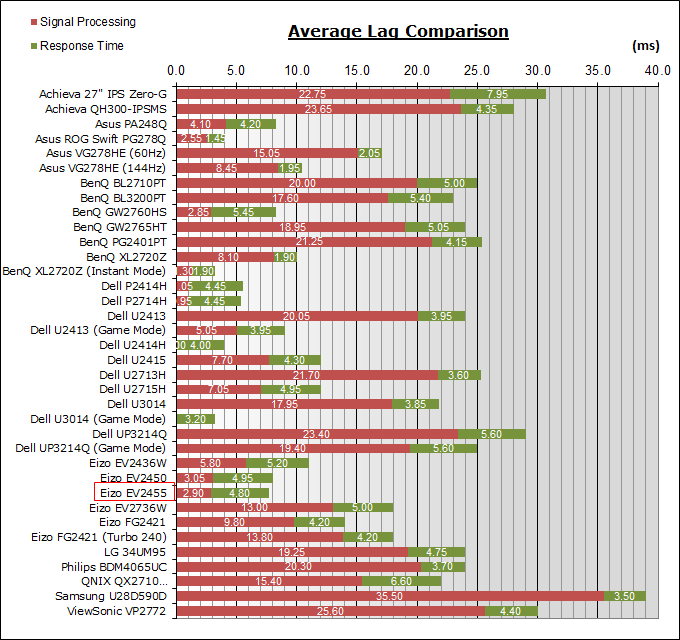
For the full reviews of the models compared here and the dates they were written
(and when screens were approximately released to the market), please see our
full
reviews index.
|
(Measurements in ms) |
Standard Mode |
|
Total Display Lag (SMTT
2) |
7.7 |
|
Pixel Response Time
Element |
4.8 |
|
Estimated Signal
Processing Lag |
2.9 |
|
Lag Classification |
1 |
|

Class
1 |
We have provided a comparison above against other
models we have tested to give an indication between screens. The screens tested
are split into two measurements which are based on our overall display lag tests
(using SMTT) and half the average G2G response time, as measured by the
oscilloscope. The response time is split from the overall display lag and shown
on the graph as the green bar. From there, the signal processing (red bar) can
be provided as a good estimation.
The screen showed a total average display lag of
only 7.7 ms as measured with SMTT 2. Taking into account half the average G2G
response time at 4.8ms ('standard' overdrive setting), we can estimate that
there is ~2.9 ms of signal processing lag on this screen. This is very low and
should not represent any problem for gaming. It is basically identical to the
EV2450 model incidentally.

Movies and Video
The following summarises the screens performance
in video applications:
-
24"
screen size makes it a relatively small option for an all-in-one multimedia
screen, much smaller than LCD TV's nowadays.
-
16:10
aspect ratio is not as well suited to videos and movies as 16:9 format models,
leaving you with larger borders on DVD's and wide screen content at the top
and bottom.
-
1920 x
1200 resolution can support full 1080 HD resolution content.
-
1x HDMI and 1x DisplayPort
connections available, so good choices for modern DVD players, Blu-ray,
consoles etc. Good to see HDMI included here.
-
Cables provided in the box
for DisplayPort only, no HDMI cables.
-
Light
AG coating providing clean and clear images, without the
unwanted reflections of a glossy solution.
-
Wide
brightness range adjustment possible from the display, including high maximum
luminance of ~321
cd/m2 and an incredibly low minimum
luminance of only 0.7 cd/m2. This should afford you very good control for different
lighting conditions. Contrast ratio fluctuates a bit across the brightness
adjustment
range but at the more comfortable settings the contrast ratio is a bit higher
anyway. The backlight does not use PWM between settings of 100 and 20 and remains flicker-free as
a result. Below that, only a very high frequency and low amplitude oscillation
is introduced, but chances are you won't need to drop below 20% brightness
anyway in most situations.
-
Black
depth and contrast ratio are very good for an IPS panel at 1032:1 after
calibration. Detail in darker scenes should not be lost as a result, and
shadow detail should be good.
-
There
is a specific 'movie' preset mode available for movies or video if you want
but it felt quite similar to our calibrated user mode. Might be useful if you
need to have different settings or brightness for movies.
-
Good
pixel responsiveness which should still be able to handle fast moving scenes
in movies without issue. No real overshoot issues which is pleasing as long as you
stick to the 'standard' overdrive setting.
-
Wide viewing angles thanks to IPS panel
technology meaning several people could view the screen at once comfortable
and from a whole host of different angles. White glow from an angle on black
content may be problematic to some users and is more of an issue than on the
low glow EV2450 panel.
-
Good range of ergonomic adjustments available
from the stand, so should be easy to obtain a comfortable position for
multiple users or if you want to sit further away from the screen for movie
viewing. Height and swivel are easy to use, although tilt is a bit
difficult.
-
No
particularly noticeable backlight leakage, and none from the edges which is good. This type
of leakage may prove an issue when watching movies where black borders are
present but it is not a problem here.
-
Basic
2x 1W integrated stereo speakers on this model for the occasional video clip,
but not up to a full movie.
-
Decent
range of
hardware aspect ratio options with aspect, full and 1:1 pixel mappings modes available which
should be fine for most uses. Good options for connecting external devices
given the aspect ratio of this screen is 16:10, and a lot of multimedia
content is 16:9 natively.
-
Picture in picture (PiP) and Picture By Picture (PbP) are not available.

Conclusion
The Eizo EV2455 was so similar to the EV2450
overall that it's hard not to repeat a lot of what we said in the conclusion to
that review. That's good news though as the EV2450 had been an impressive screen
and offered some very good all-round performance and features. It's nice here to
basically have a 16:10 aspect ratio version of the same display, for those who
prefer the slightly different format. It's mostly down to user taste of course
as to which is better. Some people who use the screen more for day to day or
office work prefer the slightly larger resolution and screen space, but for
multimedia, movies and gaming we still feel the 16:9 format is a little more
suited.
Performance wise the EV2455 was very good. Decent
out of the box setup, meaning most people won't need to calibrate the screen
even and still be able to enjoy a nice accurate setup. Contrast ratio was strong
as well once you've lowered the brightness. Eizo have thankfully kept the same
flicker free backlight as the EV2450 for most of the brightness adjustment
range. Even when a DC method wasn't used (<20%), the oscillation is unlikely to
be problematic to most users anyway. The panel featured the modern light AG
coating which was good news as well. One area where the EV2450 was slightly
better was in IPS glow. The EV2450 was a low glow panel, whereas the EV2455 is a
normal glow type.
We can compare the EV2455 briefly with the Dell
equivalent as well, the U2415, which is based on the exact same IPS panel. Pixel
response times were slightly slower here than the Dell but really you'd be hard
pressed to notice any real difference in practice. Lag was slightly lower
though, although again not by much, so this is decent option for IPS gaming
still. The default setup of the screen was a bit better on the Eizo also.
Where the Eizo begins to set itself apart from the
Dell U2415 is with some of the extra features it has. It has a better range of
video connections, while the Dell was a little limited with only HDMI and
DisplayPort options. There are speakers and audio connections which might be
useful to some. The ECO sensors are very useful and nice to have available and
set it apart for office environments. Another considerable advantage to the Eizo
was the better aspect ratio control options, overcoming a rather annoying
limitation with the U2415 where 16:9 / 1:1 options are not offered. Like the
Eizo EV2450 vs. the Dell U2414H comparison, where the EV2455 did let itself down a
little was with the stand. It was not nearly as useable as the Dell's, with the
tilt for instance being very stiff to operate. The OSD was also a little basic
looking but did at least have a good range of options so we won't worry about
that too much.
The EV2455 currently retails for £276 GBP (inc
VAT) and is only slightly more expensive than the Dell U2415 (£242). There's not much
to separate the two overall we didn't feel, although the Eizo has a few nice
extras available. This is a very realistic alternative to the Dell from another
quality monitor manufacturer.
If you appreciate the review
and enjoy reading and like our work, we would welcome a
donation
to the site to help us continue to make quality and detailed reviews for you.
|
Pros |
Cons |
|
Good default setup and great
all-round performance |
Stand adjustments aren't
great, tilt is too stiff |
|
Decent responsiveness and very
low lag for gaming |
OSD menu somewhat basic in
design |
|
Useful extra features like
ambient light sensor, motion sensor, speakers. Decent aspect ratio scaling
options also |
Not a low glow panel like the
EV2450 unfortunately |


Eizo EV2455 Now
Available
|
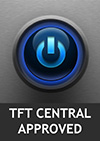
|
TFT Central Awards Explained
We have two award
classifications as part of our reviews. There's the top 'Recommended'
award, where a monitor is excellent and highly recommended by us. There is
also an 'Approved' award for a very good screen which may not be perfect,
but is still a very good display. These awards won't be given out every
time, but look out for the logo at the bottom of the conclusion. A list of
monitors which have won our awards is available
here. |